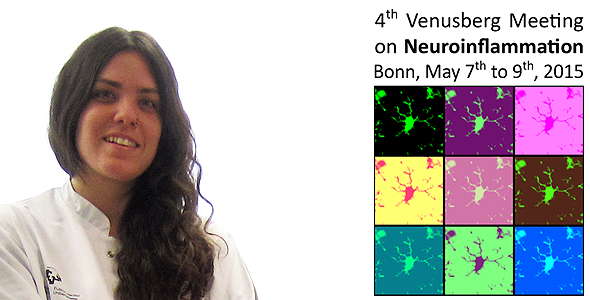Oihane Abiega awarded the Best Poster in the 4th Venusberg_Meeting on Neuroinflammation
The ACHUCARRO and UPV/EHU PhD candidate won the first prize in this scientific meeting held in the University Hospital of Bonn (Germany), from May 7 to 9.
Oihane Abiega, a Predoctoral researcher of the Laboratory of Glial Cell Biology, led by Amanda Sierra, was awarded the Best Poster prize in the 4th Venusberg Meeting on Neuroinflammation, held from May 7th to 9th 2015 in the University Hospital of Bonn (Germany).
The Venusberg Meeting on Neuroinflammation organised by Prof. Dr. Michael Heneka.

Title
Microglial phagocytosis-apoptosis coupling: a widespread response disturbed in epilepsy
Authors
Oihane Abiega, Sol Beccari, Irune Diaz-Aparicio, Amy L. Brewster, Anne E. Anderson, Agnes Nadjar, Quentin Leyrolle, Sophie Layé, Mirjana Maletic-Savatic, Carlos Matute, Juan M. Encinas, Amanda Sierra.
Abstract
Phagocytosis is a highly conserved process essential to maintain tissue homeostasis. However, little is known about its dynamics in the adult brain. Using as a model the adult neurogenic cascade, where the majority of the newborn cells undergo apoptosis, we have defined a series of parameters that establish the baseline efficiency of microglial phagocytosis in the adult brain. In physiological conditions, apoptotic cells are rapidly and efficiently phagocytosed by microglia. When subjected to different phagocytic challenges as inflammation in vivo (systemic LPS), chronic inflammation in vivo (Omega 3 defficient diet), or excitotoxicity in vitro (NMDA in organotypic slices), microglia stand up to the increased apoptosis by raising proportionally their phagocytic capacity – hence, phagocytosis remains coupled to apoptosis. In contrast, in an in vivo model of epilepsy induced by kainate administration, a major neurological disorder characterized by excitotoxicity and inflammation, microglial phagocytosis is strongly uncoupled from apoptosis. These new parameters we introduce enable us to describe microglial phagocytosis dynamics in both health and disease and represent a very powerful tool to detect disruptions in this physiological process. The consequences and mechanisms underlying this phagocytosis-apoptosis uncoupling will be discussed.
